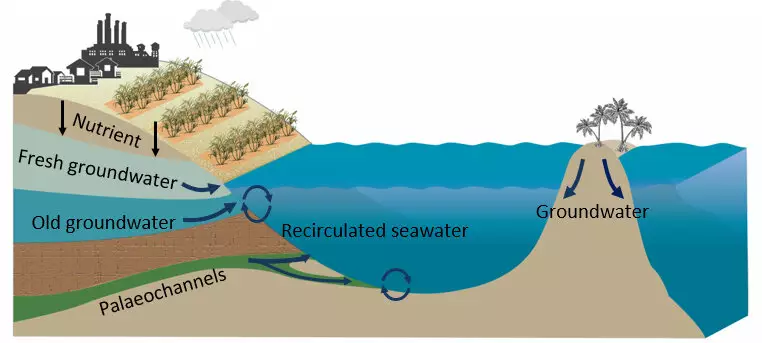Scientists conducting a study off Queensland’s coast have uncovered a previously unknown source of nitrogen and phosphorous that is wreaking havoc on the Great Barrier Reef. The findings, published in Environmental Science & Technology, have major implications for current conservation efforts. Led by Dr. Douglas Tait from Southern Cross University, the research team used natural tracers to identify submarine groundwater discharge as the primary culprit. This discharge refers to the release of water below the ocean’s surface from underground aquifers and the seafloor. The study’s results challenge the prevailing focus on river inputs and call for a new perspective on preserving the health of the Reef.
To trace the flow of nutrients, the team collected data from offshore transects, rivers, and coastal bores in an area spanning from south of Rockhampton to north of Cairns. By utilizing radium isotopes, the scientists were able to quantify the nutrient transport from land and shelf sediments via invisible groundwater flows. Astonishingly, the study revealed that submarine groundwater discharge accounted for 10-15 times more nutrients than river inputs – a previously unaccounted phenomenon. Notably, groundwater discharge was responsible for about one-third of new nitrogen and two-thirds of phosphorous inputs, indicating a significantly higher nitrogen inflow from groundwater than from rivers.
While extensive efforts have focused on reducing nutrient outflow from river systems, this study demonstrates the urgent need for a strategic shift in management approaches. Excess nutrients can trigger harmful algal blooms, starfish outbreaks, and fish diseases, all of which have surged in the Great Barrier Reef over the past few decades. Dr. Tait, the lead author, emphasized the crucial role of nutrients in supporting the Reef’s biodiversity but highlighted the detrimental consequences of nutrient overload. Unlike river outflow that quickly reaches the coast, nutrients in groundwater can be stored underground for decades, posing a long-term threat to the Reef. Therefore, research and conservation strategies must be adapted to address this hidden but significant source of nutrients.
This ground-breaking study sheds new light on the intricate nutrient dynamics within the Great Barrier Reef. The discovery of submarine groundwater discharge as a major nutrient pathway underscores the complexity of environmental management in this region. Efforts to safeguard the Reef’s health must consider not only the impact of river inputs but also the long-term consequences of groundwater discharge. By understanding the sources and transport mechanisms of nutrients, scientists and policymakers can develop more comprehensive strategies to protect this iconic natural wonder.
The study’s findings not only challenge the existing narrative but also emphasize the need for ongoing monitoring and research. Without a thorough understanding of the nutrient dynamics, mitigation efforts may fall short, endangering the future of the Great Barrier Reef. As the world’s largest coral reef system, home to an extensive array of marine species, the Reef’s preservation is of paramount importance. By acknowledging and addressing the hidden threat posed by submarine groundwater discharge, we can take a crucial step towards safeguarding this iconic ecosystem for generations to come.


Leave a Reply